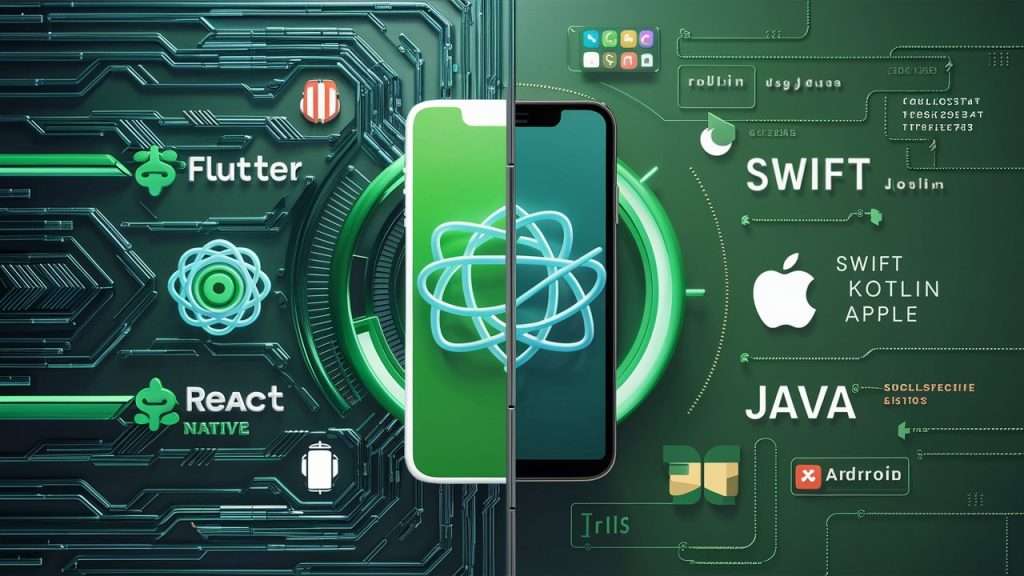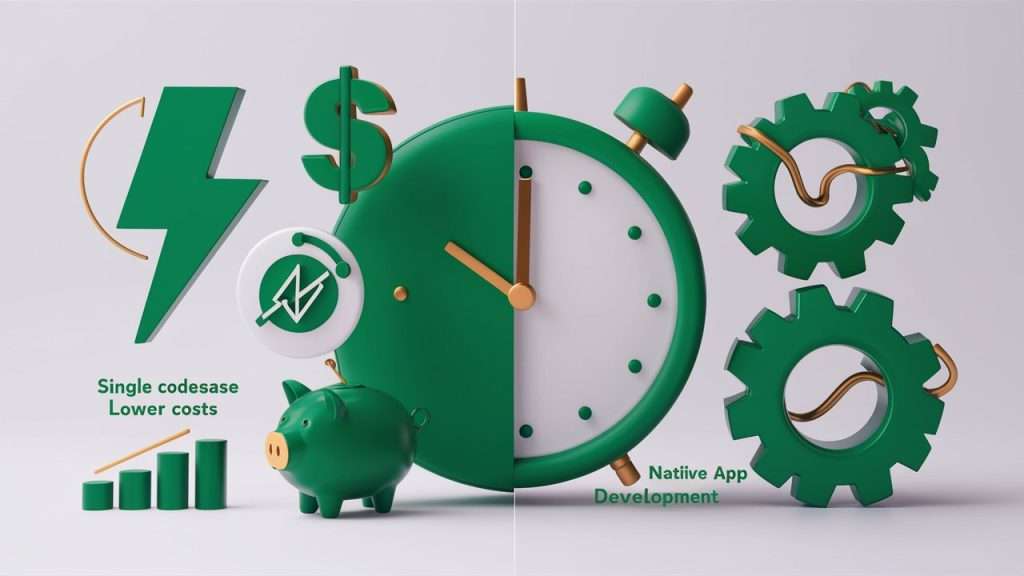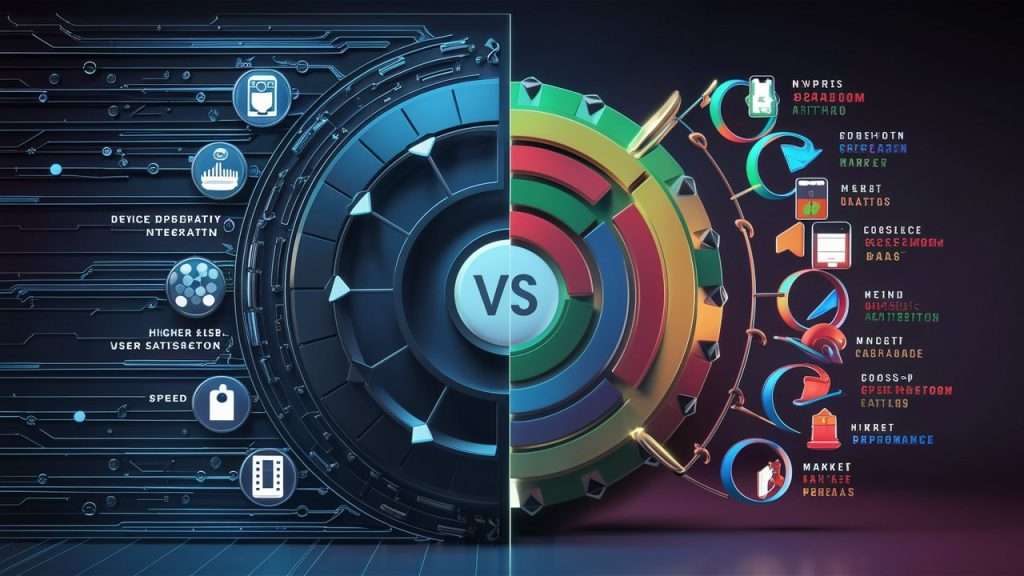In the competitive landscape of mobile app development, businesses and developers face a crucial decision: Hybrid Vs. Native Mobile Apps? Each has its advantages and disadvantages, key features, which affect usability, development time and cost. With constant changes in mobile technology, there is a important information regarding the options for a hybrid or native application that is suitable for the present and the future.
Understanding the Core Differences Between Hybrid and Native Apps

First of all in the Hybrid vs. Native Mobile Apps, Before making a decision, let control the basic differences between hybrid and native applications so you can better decide. These differences are not limited to languages and frameworks but are embedded across the full spectrum of the system, from performance to the user.
Defining Native Apps and Their Structure
Native apps are developed with consideration to a specific platform—either iOS or Android. Developed in languages relevant to each operating system like Swift/ Objective for iOS and Kotlin/ Java for android, native applications use the device’s software to its optimum. Because most of these apps are built with the platform in mind, they are fully optimized to use all facets of the infrastructure including GPU, system API access to camera, GPS and Bluetooth.
Such a strategy gives native apps a top-notch and refined performance, which affirms that it is smooth to navigate. Native apps operate and communicate more closely with the platform’s bare bones which means they are free from most of the problems that hybrid applications encounter and therefore load instantly, and have smooth animations that go hand in hand with the native platform’s looks and feels.
Explaining Hybrid Apps and Their Frameworks
Hybrid apps are quite different from this approach working on both platforms while not being optimized for any. Hybrid application development involves using web technologies including HTML, CSS, and JavaScript as the basis for creating an application that can run across multiple operating systems using a single codebase packaged and run on a native shell. Towards this end, there are frameworks such as React Native, Flutter and Ionic, among others, and all these come with integrated frameworks that help to unify the web and native development hence creating apps that look and feel like native applications though lots of code repetitiveness is avoided.
The structure has several advantages, which include the following; it helps in reaching more people, has lower development time and costs. Developing applications for different platforms out of one codebase makes it possible to bring the updates faster and get to users of iOS and Android without a creation of two different development teams. Hybrid apps run on the web view and therefore the capacity to reach all native features results to fluidity and tight integration as provided by native apps.
Comparing User Experience and Performance in Real-World Scenarios
In most cases, it is apparent that native apps still hold an ace in the game when it comes to customer experience. As a result, native applications are more personalized from a design point of view and are in a position to better take advantage of available platform and hardware specifications. Though hybrid apps are mobile app development frameworks that are anywhere close to perfect, they do have some issues of slightly slower execution or slightly less elegant layout every now and then when it comes to things like performing complex animations or any task that requires significant computational prowess.
For example an application that involves a multi-player gaming app or augmented reality app where timing is critical to performance such as smooth graphic animations will probably perform better as a native app. On the other hand, less resource and graphics intensive applications can be built as hybrid and still deliver almost the same performance, for the purpose of reaching the largest audience on different platforms possible and with shorter development cycles.
Development Time and Cost Considerations: Hybrid vs. Native Mobile Apps

In the Hybrid vs. Native Mobile Apps, There are always important issues to do with costs and time whenever one wants to develop an application. Selecting between the two programming options can help save a huge amount of money, time, and resources when going from the idea to the actual application.
Native Apps: A Heavier Upfront Investment
Compared to web and hybrid app designs, development processes of native apps are often longer and more expensive because they require separate teams and codes for each platform. For a company planning to launch a native app for both the iOS and Android platforms, the company has to necessarily build different versions of the application and this implies having to look for iOS and Android developers respectively. The result is a longer time spent on development and the higher cost of development at the initial stage.
Still, this incurs some expenses on the side of the firm, but it is always compensated by the quality and performance of the end product. But first, native application can yield better results in terms of usability and that might prove as bait to keep more users hooked especially if the core of the application is based on heavy computational operations or quick responses. This makes native development a reasonable proposition for the firms that have a deep pocket and are aiming at achieving the best user experience.
Hybrid Apps: A Cost-Effective and Efficient Solution
Hybrid app development sustains a lot of interest from businesses that wish to reduce cost and time in getting their apps to market. In this way, developing a single hybrid app circumvents the cost and time involved in creating and maintaining two distinct applications for their company All modern development frameworks provide a means for making hybrid apps, while allowing some degree of native interface interaction such as React Native or Flutter.
In relation to this, hybrid development is even more advantageous, particularly to startups, small businesses, or those projects with a short timeframe. Hybrid apps require less coding and less code to manage which make them faster to have in the market for both iOS and Android business users. The catch though is since it is not as efficient as writing pure native code, the app that will be developed is not as polished or as responsive as a pure native app and user satisfaction over time will be compromised.
Long-Term Maintenance Costs and Considerations
On the one hand, creating hybrid apps is rather cost efficient, on the other hand, there could be extra costs associated with the further app maintenance. These are those apps that are based on other frameworks and other libraries that may need to be updated as often as possible to correspond with new version of the operating system. This means that any changes to the frameworks or the operating system may require some changes to the app and herein, time as well as money can accumulate.
On the other hand, native apps are little more resistant in terms of sustaining through long periods of time. However, since they are developed solely for the operating system they are on, they have a lower level of vulnerability to issues raised by the updating of the operating system. To those companies that aim at achieving sustainable growth of an app, native development might be an even more cost-efficient way under the aspect of maintenance.
Performance, Accessibility, and User Satisfaction

From The Hybrid vs. Native Mobile Apps, The efficiency and convenience of the application’s work is one of the key indicators affected by the user. Dependency on the devices and network infrastructures can directly influence the overall utility of an app and each of them has its unique performance profile and accessibilities.
Performance Advantages of Native Apps
There is an opinion that native applications tend to be more effective than hybrid ones because of the opportunity to interact with the device and its operating system. With code tailored for each platform, native applications can enhance performance measurements such as response time, animation, and predictability of performance, particularly in use by other users, in lieu of multiple simultaneous uses of an application. For this reason, native apps are suitable for use in applications that demand maximum performance attributes, like refreshed gaming, steep video streaming, and photo editing apps.
Also, application developed in native language consumes more resources of the systems and have better access to platform specific features compared with the web applications. For instance, native applications may call device’s camera, GPS, and accelerometer of the device with possible little lag, which means a better user experience is expected. In the case where performance is important native development is usually the go-to strategies since it offers users application that will have that natural feel and usability.
Accessibility and Market Reach of Hybrid Apps
Hybrid apps are created with the goal of being reachable for mobile business, so it can reach users with both iOS and Android features under the same app. It has its advantages for those who have an interest in reaching out to as many clients as possible without spending time and money on developing two different versions of the app The advantage of using hybrid apps is due to the fact that it may help to ‘capture’ the largest amount of active users possible, which is always useful for a business that aims at penetrating the market as quickly as possible or aims at keeping as many types of clients as possible.
While being able to capture such a vast audience is a major advantage there are usually inevitable compromises with the performance of the device. Because a hybrid app relies on a single code, it will perform slightly worse than a native app; this could be quite conspicuous in devices with low processing power or in areas of low internet connectivity. For those businessmen who consider the access and the pace of the development more important than overall effectiveness, there is a hybrid solution.
Balancing User Satisfaction with Accessibility and Performance
It’s a common challenge when deciding between which framework to use for a business’s application: is it better to use hybrid or go native while staying diligent in making your app accessible for all yet offering a satisfactory experience? While native apps boast of a more immersive and professional look feel, hybrids can be deployed more frequently across platforms. To organizations which considered customer centric, native apps are more reliable and customer engaging than web apps. Still, for those companies that need to go viral and make that big initial push, hybrid apps offer relatively good performance levels for the money.
Future Trends in Hybrid and Native Development

In Hybrid vs. Native Mobile Apps, Hybrid and native mobile apps are part of the contemporary mobile app development agenda, and are already adjusting to new circumstances. The mobile application is the most popular application type that indicates that both approaches have great potential for future development due to new technologies, frameworks, and growing users’ expectations.
The Growth of Advanced Cross-Platform Frameworks
Hybrid frameworks such as Flutter and React Native are constantly evolving as developers can now harness them to construct PWA that is almost as powerful and visually appealing as the native app. Of all of those cross-platform frameworks, Flutter has become especially popular because of its level of flexibility and particularly because of the number of applications and a number of features it can offer a native-like experience. These frameworks are still immature but they are extending the gap between hybrid and native suggesting that in the not too distant future hybrid apps will be performing almost as well as native Android apps.
The Rise of Progressive Web Apps (PWAs)
The recent revolutionary concept in the app development is Progressive Web Apps (PWAs), acting as the bridge between web and mobile apps. Eight of the 10 most visited sites in the world have PWAs, which work like standard websites but can be added to a home screen for offline use with push notifications. They are not able to perform to the optimum as the native or hybrid apps; nonetheless, they are inexpensive and easy to implement, and this makes them fit the bill for business entities that seek to reach as many people as possible with little capital as would be required in their production and deployment.
Possibility of Convergence in Hybrid and Native Development
As the progresses made in both native and cross-application development, some of the strategists believe that there will certainly be a blend of hybrid and native applications. They likewise may plateau and offer performance and user satisfaction equivalent to that of applications specifically developed for the distinct channels. This could be a future where companies no longer need to decide between which one between hybridization and native app as both will be similar to one another.
Summary
The decision of proceeding with hybrid or native app development is influenced by different aspects for instance, cost, speed and usability. Native apps have the best performance and the overall quality of application, which is perfect for organizations that depend on customers. Hybrid apps, in contrast, provide more cost efficiency and give the ability to launch applications for multiple platforms, so they are appropriate to use for businesses, which aim at catering to a large number of users. As with the new frameworks and potential integration, both seem to be progressing towards a future where hybrid and native possibilities will be one and the same in mobile application development.

